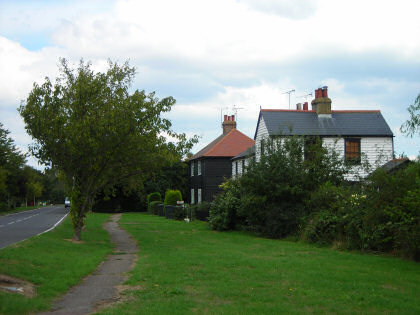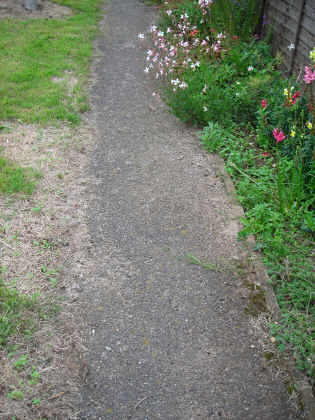Foulness Churchend Conservation Area Appraisal and Management Plan
8. Recommendations
Street scene and amenity space16
8.1 Soft verges are a characteristic feature of the village and should be retained (Fig. 48). The use of hard edges and kerbs should generally be avoided. Rough demarcation of pedestrian footpaths and carriageways enhances the rural character of the village (Fig. 49).
8.2 Surface treatments and dressings should be appropriate to the rural character of the conservation area. Most of the historic tracks in the conservation area are grassed over or of old compacted gravel. Bound gravel or pea shingle are suitable dressings in rural settings. As a point of interest, John Dobson, a long standing former resident of the island, recalled that historically crushed cockle shells featured on well maintained paths around the village, the shells deriving from the shell banks on the eastern coast of the island17.
8.3 Street clutter currently detracts from the visual attractiveness of the village, particularly around the historic core, and should be reviewed and rationalised. Any surplus or excessive elements should be removed, particularly around the main road junction. Consideration should be given to the design of signage and street furniture in terms of materials, size and form so that it is sensitive to the unspoilt rural context of the village. Accepting that Foulness is a functional military establishment, the designs do not need to be overly heritage based. The designs should be co-ordinated and consistent as far as possible, for example with similar coloured poles, a dark receding colour being preferable. Where safety is a concern, as at the road bend where the crash barrier has been installed, solutions should be sought that are sympathetic to the context. Road markings should be used sparingly within the historically sensitive village environment whilst maintaining safety standards, and existing markings should be reviewed with a view to future simplification. As a general principle, a minimalist approach to traffic management is recommended.
8.4 The village green is a valuable amenity space not only for Churchend but also providing a community focal point for the whole island. At present this space is not well defined, and is barely distinguishable as a community space. A few benches of an appropriate design for the rural setting would add to the amenity value of the green, and perhaps tidying of the scrub and better definition at the boundary. Somewhat in contradiction to earlier comments about signage a suitably designed village sign drawing on local history and character would not be out of place here.
8.5 Green spaces and trees are an important element in the street scene.These must be properly maintained to preserve their attractive appearance and avoid the encroachment of scrub, as well as to protect views within the conservation area and views out and in. There is some anecdotal evidence that scrub has grown up in recent years, with views to the rectory for example more obscured than they once were. An old pond, which is a historic feature now cut through by the spinal road near the road junction, has become overgrown. A maintenance programme is required to ensure the effective management of these green spaces and important landscape features. Tall Leylandii hedges are also alien features in the landscape. Native species would be more appropriate for the conservation area.
Property Maintenance
8.6 In the past property repair and maintenance within the conservation area has involved the loss of historic fabric and features. Listed buildings are the subject of quinquennial reviews, and plans are underway for these to include not only a condition report on the buildings but also a plan for any works required. However unlisted buildings also contribute to the character of the conservation area, including historic and more recent 20th century buildings. A repair and maintenance programme should be in place that takes into account the particular features of properties that contribute to the special character of the conservation area. This should also include provision for enhancing the area by reinstatement of features where they have been lost, for example in the case of traditional fenestration and doors. Unauthorised alterations such as changes to windows and doors and exterior painting are not permitted under the terms of tenancy agreements, and can therefore be managed by Defence Estates to ensure the special character of the built environment is preserved and enhanced. Boundary treatments must also be a feature of the plan, with proper maintenance of historic walls which are an important element in the conservation area.
8.7 At present tenants are free to choose their front boundary treatments. Use of traditional boundaries like picket fences, post and rail fences and hedges should be encouraged. The treatment of rear boundaries should also be considered as significant where they are viewed from public footpaths.
8.8 Properties that appear neglected detract from the attractive visual character of the conservation area. The village hall is an eyesore that is desperately in need of either repair with tidying and landscaping of the plot, or demolition to be replaced by something appropriately designed. As the building is adjacent to the conservation area, any new building would have to conform to strict design criteria in accordance with policy BC1 of the Rochford District Replacement Local Plan. The treatment of the plot should respect the old byway that leads eastwards away from it. The agricultural outbuilding near the Old Hall requires basic repair and maintenance of the exterior which would reduce the negative impact that the building has in the streetscape. Ideally a new use should be sought that would not involve unsympathetic alteration.
8.9 The site of the water pump is also neglected at present. This is a distinctive local feature with an important place in the history of the island, but is in danger of being forgotten and engulfed by scrub. Some basic clearing of vegetation should be undertaken to prevent loss and damage to this feature.
Future Development
8.10 At present there is little pressure for new development in the conservation area. Any new development would need to take account of the special character of the area in terms of its materials, design and scale, in accordance with policies BC1-2 of the Rochford District Replacement Local Plan. Generous plots with gardens are characteristic of the conservation area and development within garden spaces should be avoided. However there is a vacant plot between numbers 18 and 7 Churchend which could accommodate a new property. It is essential that any significant new development respects the historic ditches and trackways that are intrinsic to the local distinctiveness of the conservation area.
Historic Environment Management
8.11 The wider landscape of the island is of great importance historically and archaeologically, as well as for its natural landscape value and ecology. The conservation area incorporates features that contribute to the overall landscape significance of Foulness, including ditches, tracks, ponds and earthworks. In addition to these ancient features, the widespread surviving evidence of past military activity on the island constitutes a rich military heritage.
8.12 Defence Estates are currently preparing an integrated Rural Management Plan for Foulness that will provide a strategy for managing the complex elements of the landscape both natural and man-made. This appraisal will be used to inform any plans affecting the conservation area.
8.13 The Shoeburyness Conservation Group is a partnership of organisations including the Foulness and Conservation Archaeological Society and the parish council, who set out to safeguard the historic and environmental assets of the island, and which can be instrumental in ensuring that any developments within the conservation area take account of its special character. At present the membership of the group has a strong emphasis on the natural environment, and it is suggested that representation from the historic and archaeological environment is increased.
8.14 English Heritage are shortly to publish a report based on a desk-based survey of the heritage assets of Foulness as a whole. This will be a valuable tool both for Defence Estates management of the historic environment and for re-evaluating heritage protection across the island.
16 English Heritage provides regional guidance on management of streetscapes in historic areas. See Streets for All: East of England, 2005.
17 Dobson, 1996, 24


